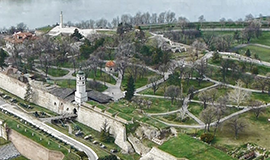Jewish community of Serbia history
The history of Jewish community of Serbia goes back about two thousand years. Jews first arrived in what is now Serbia in Roman times. The Jewish communities of the Balkans remained small until the late 15th century, when Jews fleeing the Spanish and Portuguese Inquisitions found refuge in Ottoman-ruled areas, including Serbia.
The community flourished and reached a peak of 33,000 before World War II (of which almost 90% were living in Belgrade and Vojvodina, northern province of Serbia). About two thirds of Serbian Jews perished in the Holocaust. After the war, great part of the remaining Jewish Serbian population emigrated from the country, chiefly into Israel. In the 2011 census only 578 people declared themselves as Jewish.
Today, the Belgrade Synagogue is the only functioning synagogue. Other synagogues, such as Subotica Synagogue, which used to be the fourth largest synagogue building in Europe, and Novi Sad Synagogue, have been converted into museums and art spaces.
Synagogue buildings of Serbia
Belgrade Synagogue cornerstone was set on June 15, 1924. The building was finished on November 1, 1925. The ceremonial dedication of the synagogue was conducted during the summer of 1926, when the interior was finally finished. It is an Ashkenazic synagogue whose cornerstone was bi-lingual, Hebrew and Serbian, and signed by Rabbi Shlang, King Aleksandar Karadjordjevich and Queen Marija.
Novi Sad Synagogue is one of many cultural institutions in Novi Sad. The synagogue has been recognized as a historic landmark. It served the local Neolog congregation. The new synagogue, the fifth to be erected at the same location since the 18th century, became a major project for the entire Jewish community of Novi Sad, on which construction began in 1905 and was completed in 1909.
The building of the Jewish Community Subotica was built in 1902, at the same time as the building of monumental New Synagogue. It is located in the city center and is protected as a valuable architectural heritage of Art Nouveau inspired builders: Dežea Jakaba (Jakab Dezső) and Marcela chamber (Marcell), who designed the synagogue, the city hall and some buildings in Subotica, letting her epithet Art Nouveau town.

